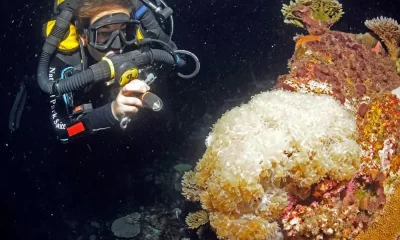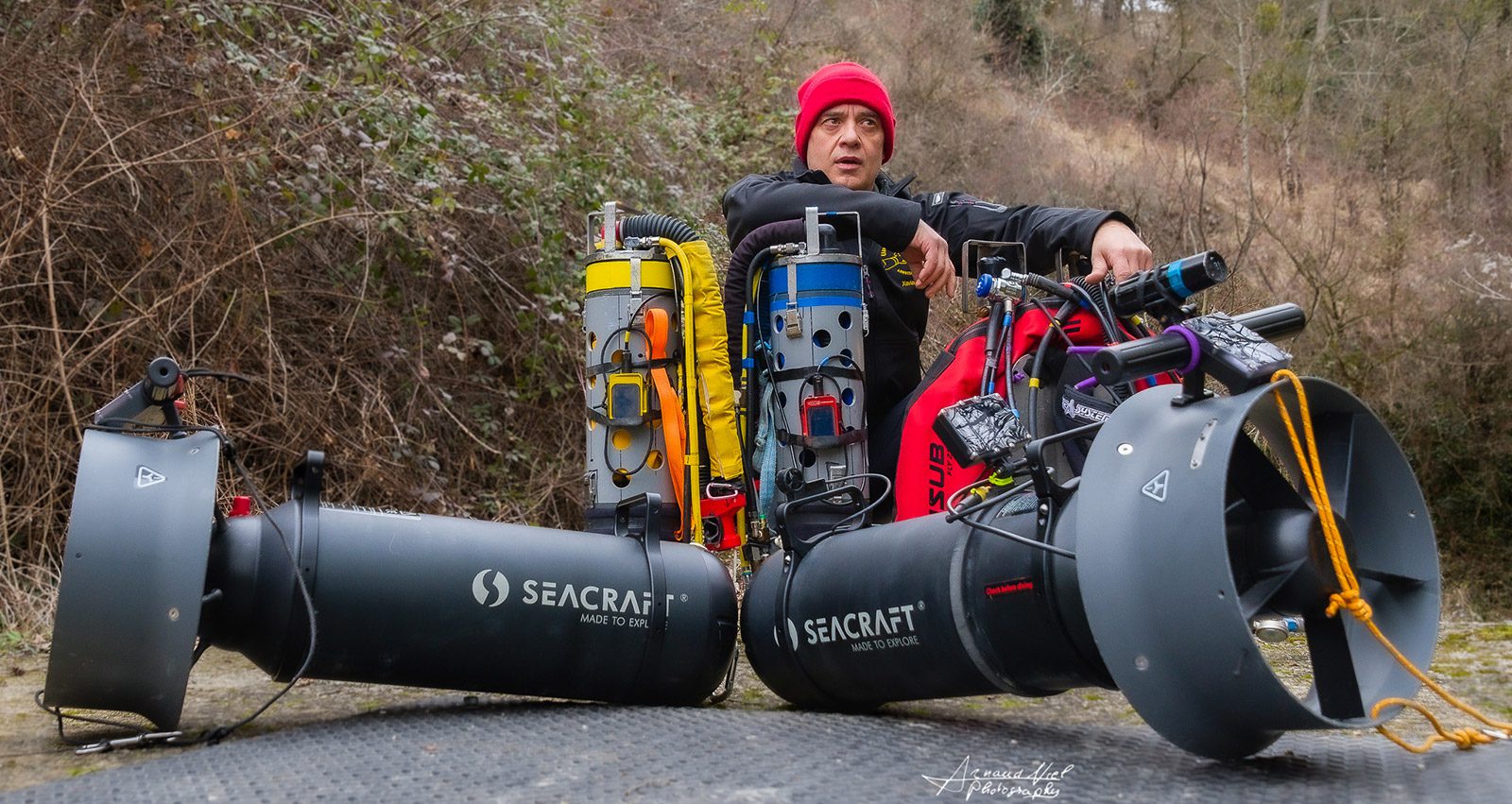

Community
Über-deep with Cave Explorer Xavier Méniscus
Xavier Méniscus is one of a handful of elite cave explorers who consistently push sub-200 meter plus depths; he holds the record for the deepest cave dive. To accomplish these dives, the former French military and commercial diver utilizes three rebreathers, and is known to possess unusual physiological tolerances that have allowed him to exceed limits without adverse consequences. InDEPTH chief Michael Menduno reached out to Meniscus to discuss his penchant for exploration and his unique approach to cave diving.
By Michael Menduno, with help with translation by Didier Drageuiev. Photos courtesy of Xavier Meniscus.
Fifty-five year old French cave explorer Xavier Méniscus is one of a handful of elite divers making sub-200 meter cave dives and holds the record for deepest cave dive at 286 mfw/938 ffw, which he conducted at Font Estramar in 2019. Méniscus, who was trained at the Institut National de la Plongée Professionnelle (INPP) in Marseille, is a former army combat diver, and a commercial saturation (SAT) diver with COMEX. He started cave diving in 2000, while still a SAT diver, and has explored many caves around the world such as the Goul de la Tannerie in France, the Pozo Azul in Spain, and Boesmansgat in South Africa. Méniscus is also a cave diving instructor with the Fédération Française d’Etude et des Sport Sous Marin (FFESSM). Méniscus recently published a book on his cave exploration work, Les mysteres de l’eau en pays Gervanne entre l’emergence de Bourne et les Fontaigneux, [Translation:The Mysteries Of Water In Gervanne Country Between The Emergence Of Bourne And The Fontaigneux], which is available in French. InDEPTH sat down with the ardent French explorer to discuss his approach to deep cave exploration. Here’s what he had to say.
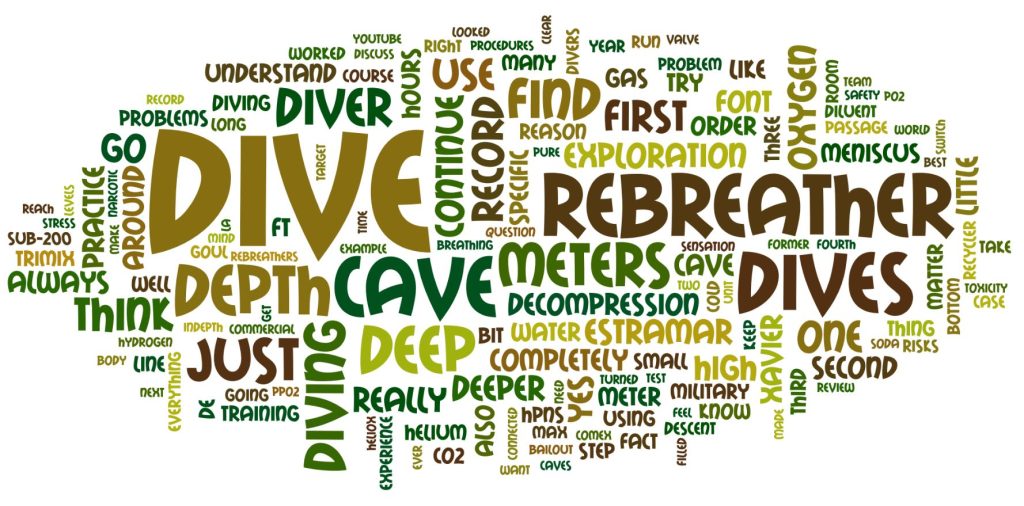
InDEPTH: Xavier, I would like to discuss your record deep dive to 286 meters at Font Estramar, but before we do, I would like to get a little background on you and your diving. How many sub-200 meter dives have you conducted?
Xavier Méniscus: I have done more than 2,000 hours of rebreather diving in caves and have made around 50 sub-200 meter dives.
Amazing. What is it about deep diving that you find alluring, that draws you?
Mike, it’s not the depth. The depth doesn’t matter. There is no specific target. My goal is to explore and to find what is behind the next cave, and the next. That’s the only thing that matters. There is no sense to go deeper just for the record. If you go deeper, if you take risks, it’s for exploration. Because exploration matters, and the record—it doesn’t matter. It’s completely not the point. This is the reason why I don’t want to have the Guinness record. It doesn’t matter for me. My motivation is exploration.
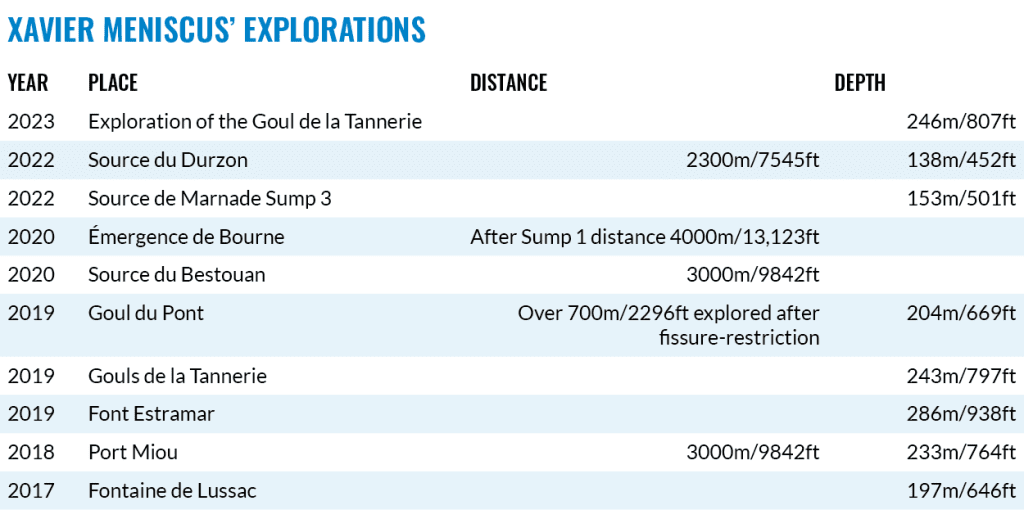
That’s good. I understand. How do you manage the challenges and risks on deep sub-200 m cave dives? How do you prepare yourself?

I have been a military diver and commercial diver, a saturation diver working with COMEX, and have worked with researchers and hyperbaric doctors, and so I have specific knowledge and understanding of the phenomena and risks. So, because of this knowledge and experience as a professional diver, I have constructed my own decompression and diving procedures.
About the risks, as a military diver I am very, very rigorous about following procedures. I prepare and think out everything step by step ahead of time in order to be very precise on the dive. And it doesn’t matter if it’s a 50 m/164 ft dive or a 200 m/656 ft dive, I follow the same checklist and procedures.
Yes, that makes perfect sense. There is little or no margin for error.
I’m very rigorous, and I review all the aspects of the dive before-hand and review them in my mind as I am conducting the dive. Okay, step one is here, I check this. Step two, I check that and then I continue. And of course, there is always the awareness, call it adaptation to the depth and the cave, of where I am, and what is really the most dangerous thing specifically in the moment. I try to keep all the specific things in mind as I proceed.
Let’s talk about your equipment. I understand that you use a triple rebreather.
That’s right. I took an example from famous cave explorer Olivier Isler, who had been diving since the 1990s using a triple rebreather. I worked with Frédéric Badiér, who had designed a homemade semi-closed recycler called Le Joky. I worked with him to modify the unit to a mechanical closed circuit rebreather with a constant mass flow at 0.7-0.8 liters per minute flow. It’s a very simple unit with a 2.5 kilo canister, breathing bag in the central part of the rebreather with a mechanical KISS valve. The unit has three sensors connected to a Divesoft dive computer. It’s a basic rebreather.
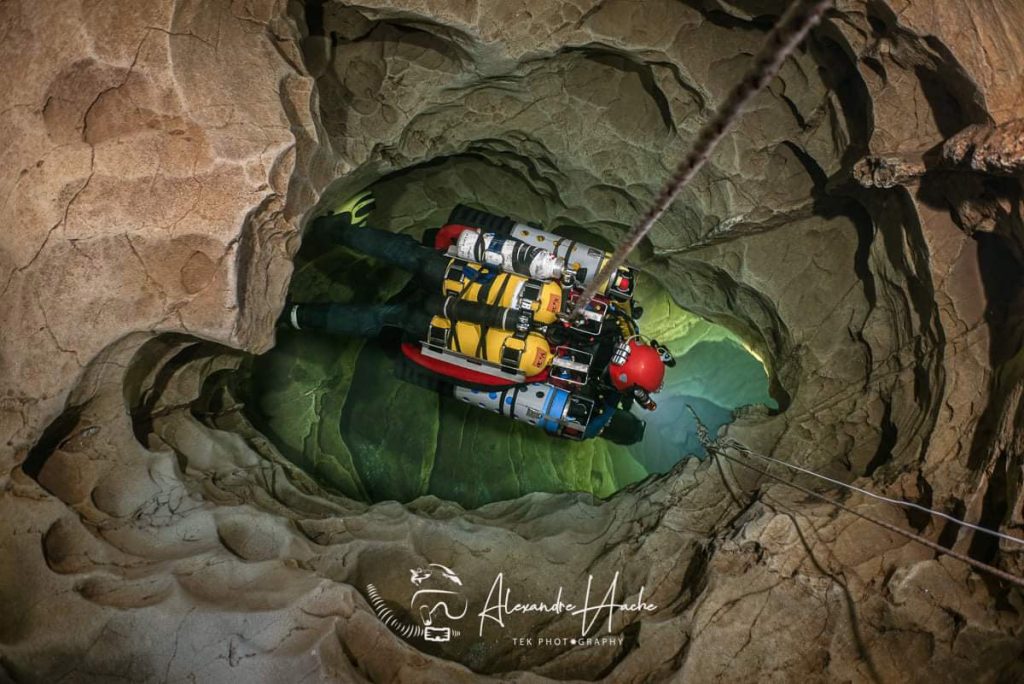
And you use three of them. How do you position them?
I wear two rebreathers on my back—one on the left side, the second one on the right side—and one on the front. The recyclers are the same, exactly the same. I breathe on one, the second is a spare and there’s a third in case I have problems during decompression. So, I can switch from the first, second or third one if I need it. There are interchangeable connections for oxygen and diluent of course.
My protocol is that I only use my main rebreather. I test my second rebreather at strategic points during my dive, for example before leaving, before the deep or narrow zone. The third rebreather is placed at the safety landing, connected to its diluent. The dive computer of my second rebreather has the PPO2 display permanently displayed and I take a look at it very regularly. If it was not waterproof, it would fill with water and become negative, so I would notice this and stop my dive. Also, on long dives, I switch to my second rebreather after 9-10 hours. The third recycler is always just the security. Which is really the worst case, you know.
So, you always dive them as a trio?
When dives are extremely long and very demanding, having three rebreathers is essential. When the dives exceed 7-8 hours, I take a third rebreather.
And just to clarify, the units are all independent. They are not connected by a bailout valve (BOV) or other means.
No, it’s completely independent; there is no connection between the left and right rebreather and there is no BOV as well. It’s just a simple mouthpiece. So if you want to switch to the second one, you turn off the first one and you go to the second one. You need to do that manually.

Have you ever had to bail out on a dive for real on your rig, and how was that?
I only had to use my social security recycler once. It was at Baume des Anges. When crossing an inter-siphon, I dropped my main recycler. The counter lungs were damaged, and when passing the next siphon at a depth of 100 m/328 ft, my rebreather filled with water. I was then forced to return with my safety rebreather.
Gotcha. And just out of curiosity, do you wear a rebreather safety strap i.e., a ‘gag’ strap?
Yes, I’m a former military diver. It’s completely mandatory for us, even for a dive of three meters, you know. This thing can save your life. This is clear.
I understand that you run your oxygen levels very high on your rebreather. Talk to me about that.
During my descent, I keep my PPO2 (partial pressure of oxygen) at 1.4, just to have a little margin if I descend very, very quickly, in order to not completely blow up the PPO2. After the descent, I try to keep my PPO2 at 1.6 for the entire rest of the dive.
Wow, that’s surprising! Why do you run your oxygen that high? I mean, it might decrease your decompression obligation, but aren’t you worried about getting a CNS toxicity hit and convulsing?
So, first of all, I tolerate the high oxygen pressures very well. I haven’t any issue with that. My experience as a military and professional diver taught me, step by step, what the human body is capable of and that my body tolerates high levels of oxygen.
[Ed. Note: Do NOT Try This at Home!!! The overwhelming community consensus is to maintain PO2s below 1.6 atm during the working portion of the dive, and the trend has been towards lower oxygen levels, particularly on big dives. GUE for example, sets its maximum at 1.2 atm during the dive with the option to manually boost PO2s to 1.3-1.4 during shallow decompression. CNS oxygen toxicity convulsions have been recorded at PO2=1.4, and can occur at PO2s less than 1.4 atm in the presence of heightened CO2, which occurs when gas density is high, whether or not it is felt by the diver. Susceptibility varies among individuals and within the same individual at different times. There’s no evidence that tolerance to oxygen toxicity can be improved through practice.]
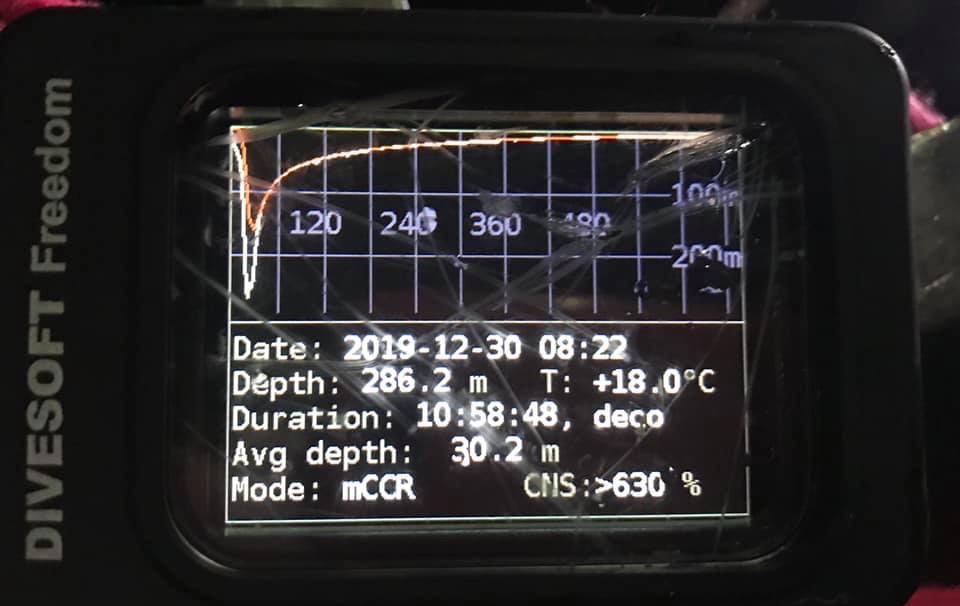
You may have a high tolerance. But do you ever worry that you are just lucky, and one day you might convulse? Have you ever had an oxygen convulsion?
I’ve never had any toxicity or convulsions with oxygen. My longest exposure was a dive lasting over 13 hours during my last exploration of the St Sauveur chasm in 2013. At that time, we weren’t using a double DPV or taking into account the PPO2 measurement from my computers. I did a total of nine hours at 1.6 bar and the last four hours at 1.9 bar in a bell at a depth of 9m/30 ft.
It’s true that when I came out of the water, my lungs were burning a bit for several hours but it disappeared the next day. To avoid too much oxygen toxicity, I take ‘air’ breaks after seven hours of diving, and breathe air or bottom mix for 5 minutes every half hour.
Do you worry that others will try to follow your example and run their working PO2 setpoint at 1.6 and get hurt? I’m sure you know that PO2=1.6 is outside of current accepted community practice except possibly during shallow water decompression, particularly for CCR. What are the standards for oxygen levels in the Fédération (FFESSM)? What do you teach your students?
In France, we recommend a PPO2 of 1.4 for progression [the working portion of the dive] and 1.6 for decompression. That’s what I teach. The use of high PPO2 for me is a necessity at the depths I go to in order to reduce the inert gas load and limit my very long decompression times as much as possible. It’s an approach that I’ve validated through my training, my long experience and my personal physiological resistance. It is also obvious that on such extreme dives, we push the sliders to the maximum.
[Ed.note: According to V-Planner calculations, boosting PO2s to 1.6 during the working portion of a 286 m dive for a 22-minute bottom time vs maintaining a PO2=1.0-1.3, results in some, but not a significant decrease in overall decompression time. It does however greatly increase the risk of CNS oxygen toxicity. ]
I understand. How deep you run your END (equivalent narcotic depth)? I understand you are using trimix.
I always use trimix with a high level of helium. I maintain my equivalent narcotic depth to around 30 m/100 ft. I always keep a little nitrogen fraction into the mixture and do not use a pure heliox because of the high pressure risk.
Not only that, I think it’s better to have a very, small narcotic sensation during the dive. A very small, very tiny sensation of narcosis. This acts as a reminder to me that says, “OK I am very deep and I need to be careful.” So, it’s a kind of alert. These are the reasons I don’t use pure heliox.
That’s understandable on deep tech dives because of High Pressure Nervous Syndrome (HPNS). Has HPNS been an issue for you?
Interestingly, during the descent, I often have the sensation of cold, above 200 m/656 ft, which could be the trimix, which is very near to heliox, in fact, with high levels of helium. Of course, the automatic diluent valve (ADV) is injecting the very cold diluent, and that could be the reason for my shakes. Then, for 20-30 seconds,when I reach 230-240 m/755-787 ft. I experience shaking, trembling, and some eyesight problems. However, when I continue my descent, the effects begin to disappear, and when I reach 260 to 280 m/850-920 ft, there is absolutely no effect. It’s over. It’s just 30 seconds or so at 230-240 meters.
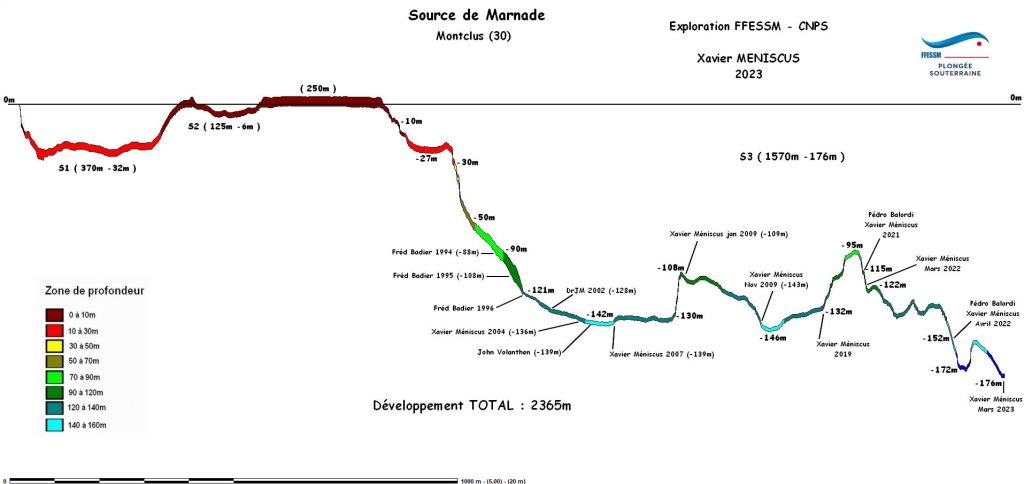
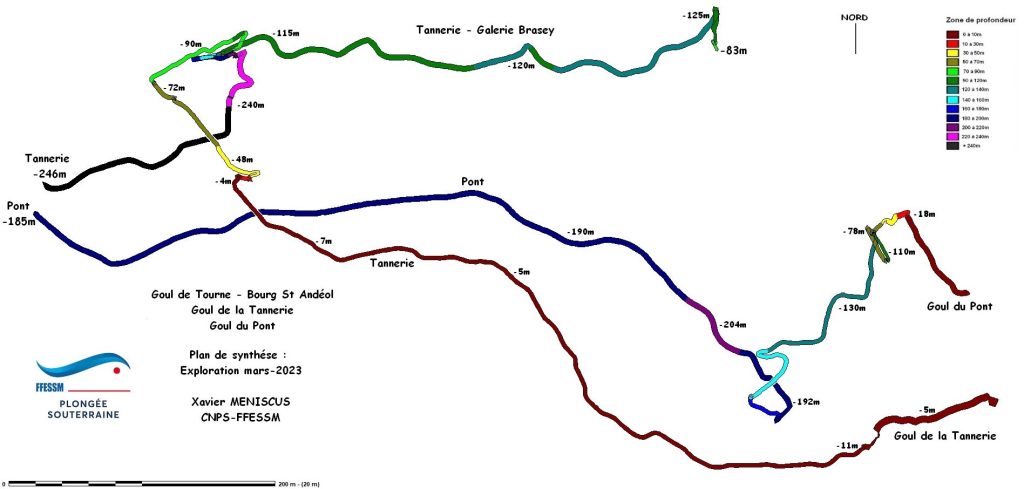
Wow. It would seem that you are not affected much at all by HPNS. Again, it sounds like you have some unique physiology.
That’s exactly what I think.
Has anyone studied you to figure out how you can do what you do? Are you aware of any reason why this is?
It’s just practice and training, practice and training, that’s all. Year after year, dive after dive, I gradually began to have a low sensitivity to gas toxicity. I think that’s really the most important thing. The key is really the practice and the training.
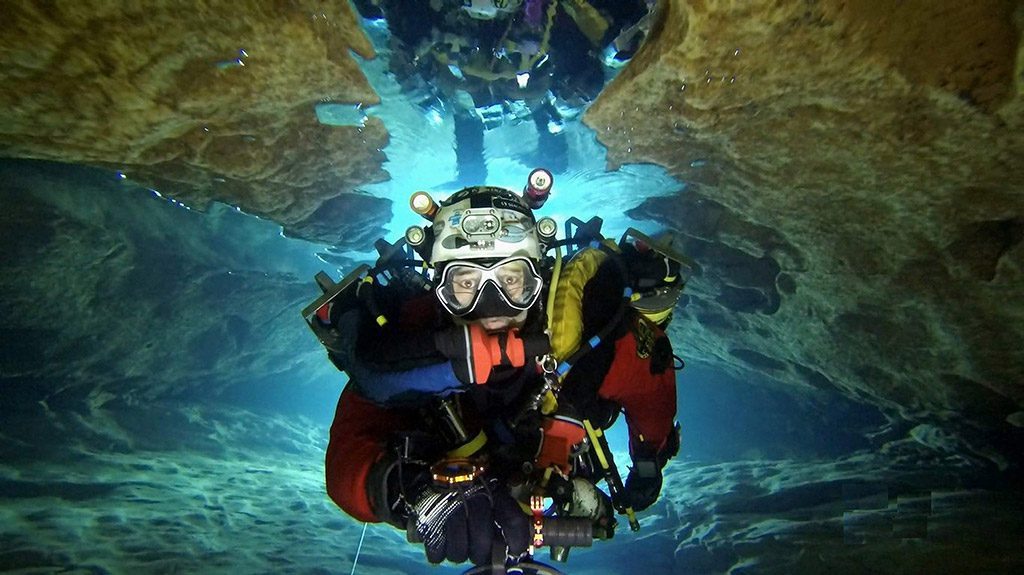
I am not aware that divers can modify and or improve their gas tolerances through practice and training. I’m pretty sure that’s the case with nitrogen narcosis, despite what some have to say. Have you had any problems with carbon dioxide (CO2) buildup? Any CO2 problems?
This is an interesting question. There are two principal things about CO2. First of all, always choose the best performing soda lime for deep diving. You can use the cheap version of soda lime for shallow dives—it doesn’t matter. But for deep dives, below 200 m/656 ft, you should always choose the best performing product for that.
The other thing is during the decompression. During very long decompressions, like eight, nine, or ten hours of decompression, the human body produces a very small quantity of CO2. That’s the reason why I am able to do a 10-hour dive on the same rebreather with only 2.5 kilograms of soda lime inside. So, no, I have never had any problem with the toxicity of CO2. I don’t think I am very sensitive to it.
Have you ever had a caustic cocktail?
Yes, just once. I had just made a ventral rebreather. During my first dive, a connector on the counterlung came loose, and the rebreather slowly filled with water. At the end of the dive, at the surface in the basin, I put my head down to test breathing comfort. The caustic cocktail went into the mouthpiece and I breathed it in. I had a bad cough and a broken voice for several days.
Last question before we get on to your dive, what kind of support team do you use for deep dives? Do you use support divers? Where are they positioned?
I typically have a team of six divers, not more, positioned down to 80 m/262 ft. I have a diver wait at 80m/262 ft to be available for help if needed, and I descend from there by myself to make my dive.
So you are diving solo at depth. That seems to be the typical practice for über-deep dives with the exception of Richard Harris & Craig Challen and the Wet Mules. Do you ever think about doing these uber-deep dives with a team mate at depth vs doing the bottom portion by yourself with support divers high above you in the cave? Would it be safer?
In fact, it is safer to do this type of diving as part of a team. In most cases, I have a team around me. A dive director and support divers who intervene at different depths. In general, the maximum depth at which my team members intervene is the one where they can spend a lot of time waiting for me if I’m late. Usually, as I just mentioned in the 80m/262 ft zone. Having used more than 20 support divers on some occasions, I now limit my support team to a maximum of five or six divers. That makes it simpler for the dive director to manage. The support divers can make up to two assistance dives during the operation, the second dive being mainly during my final stops.
When the depth allows it, and other divers can accompany me, I prefer to dive in pairs. Like my explorations of Baume des Anges with Rick Stanton and John Volanthen or Durzon and Marnade with Pédro Balordi.
OK, let’s talk about the dive at Font Estramar. Let me first ask, how long you have been exploring the cave and the dives you’ve made there.
My first dive in this cave was in 2013. I did four successive operations in the same year in order to clear the record.

And the dives went as planned?
Yes. My first dive, the first exploration dive in this cave was to a maximum depth of 180 m/591 ft. My second dive was 248 m/813 ft, the third dive 262 m/859 ft, and fourth dive, just before the record, I spent at the same 262 m/860 ft depth with 40 m/130 ft of horizontal exploration, trying to find the way forward. I was unsuccessful, so I turned the dive and ascended.
I understand that you tested your rig in a hyperbaric chamber down to 320 meters/1050 ft of depth before the fourth dive in order to make sure everything worked well before going deeper.
Yes, I tested it in Switzerland with no problems.
Good. Everything checked out. So, you were able to find going passage on your fifth dive at Estramar and go deeper and ultimately ended up setting the record.
Exactly. So, after my fourth dive, I did an analysis of the videos, images, and everything I could remember about the environment. The result was I chose to think about continuing horizontally without going deeper. So, in planning the dive I prepared gases for a max depth of 280 m/919 ft. I used trimix 5.5/83 (5.5% oxygen, 83% helium, 11.5% nitrogen).
That’s a gas density of 10.76 g/l at max depth with the high oxygen and nitrogen levels, which is considerably above the recommended max of 6.2 g/l. Are you worried about your gas density or feel that it is OK for you?
As far as density is concerned, at the depths I go, it’s difficult to respect the recommendations, but as my JOKI rebreathers are very easy to breathe, compared with commercial equipment, breathing is very fluid and doesn’t bother me at the bottom. The most important thing is not to work hard and to use a diver propulsion vehicle (DPV). What’s more, I cycle regularly—at least 5,000 km a year—to get the basic training I need to control my breathing during a violent physical effort.
Back to the dive: you were able to find the way deeper into the cave?
Once I was on the bottom and into the terminus room of the cave, I looked all around me in order to find a pathway or passage. In fact, I didn’t find anything. But then I looked in the direction of the bottom and found a hole or well. That was the way deeper, and I spent another 30 minutes in the cave exploring.
You must have been excited! How far did you push it?
It was really a pure exploration at this depth. There was a passage, but it was a very, very small passage into this well. At around 270 m/886 ft, I found another room, a little bigger. At that point I had to make a decision. I knew I was very close to the world record, so I decided to try to push a little bit more to 286 m/938 ft, and then I turned the dive and began my ascent. I had not planned to go that deep, and in fact had a bit of stress.

What happened?
I returned to the room at 262 m/860 ft, which was a bit tricky, and looked around but couldn’t find the line. I searched with my light and didn’t find it. I could feel my adrenaline and stress rise. Imagine losing the line at that depth.
OMG! That would definitely generate some stress!
One of my ties came completely undone, and the line had floated to the top of the room, where I couldn’t quite see it. The visibility is never good in Font Estamar. Fortunately, I did find the line after some tense minutes and continued my ascent.
Do you feel that you were at your physiological limit at that max depth? Or did you feel like you could go further in the future?
As I mentioned, I had some signs of HPNS when I hit 286 meters, but within a minute or so, there was nothing. All signs disappeared. I had a completely clear mind when I was trying to find the line. This is really proof to me that there is not a problem with the gas at this depth. Which means I can continue.
As you know, Richard Harris, aka Dr. Harry just completed a 230 meter test dive with a hydreliox mix (oxygen, hydrogen, helium) in order to lower the gas density and work of breathing and possibly ameliorate the HPNS. Have you given thought to using hydrogen?
Of course, I have talked about hydrogen with Jean-Pierre Imbert and Bernard Gardet, who was the scientific director at COMEX. But there is no problem for me right now. Using a rich trimix is not a problem. I only have the slightest tremors which then go away. So no, I don’t think there is a reason to change anything. I think I can continue to 300 m/984 ft with helium.
Have you had any close calls on your dives?
Yes, a Bonex scooter that I was towing between my legs imploded at the bottom of St Sauveur. It had suffered some shocks on previous dives in very narrow cavities. The explosion tore a hole around 3 cm in my drysuit—it was no longer a drysuit, but a wetsuit. It was completely filled with water during my seven hours of decompression.
OMG! How cold was the water?
13°C for seven hours! Yeah, it’s a little bit cold.
Were you using a habitat, deco habitat?
No, no I wasn’t.
That must have been grueling.
It was.
Have you ever gotten bent? Decompression sickness?
No, no, no, nothing. Again, I think it’s my physiology, and the rigor and specific training and practice, being careful every time for everything I do.
What are your plans for the future Xavier?
This Fall, I would like to continue my explorations of the Gouls of Tourne and try to find the junction between Goul du Pont and Goul de la Tannerie. And I plan to continue my explorations at Port Miou, which is not deep, and also the Source du Marnade and the Durzon.

I am guessing that you have specific goals and objectives for each.
Yes, many goals, and many objectives, in fact. To simplify, the object is to map and explore the different sites, continue to find new galleries, and in the case of Goul du Pont, find out if there is a connection.
So many caves, so little time! Will you also be returning to Font Estramar. Do you plan to go deeper there?
It’s not a principal target. I continue to think about it and try to make the best decision about this specific site. But it’s not the first target. I want to continue the exploration of the other sites first, but I do think it’s possible to reach 300 meters at Estramar.
Good luck to you Xavier! We’ll be watching. Thank you!
DIVE DEEPER
YouTube: World Record Cave Dive -286.2m (939 feet) 30-déc-2019 VF – Xavier MÉNISCUS – Font Estramar
YouTube: World Record Cave Dive – 282.6 m (927 feet) – Nuno Gomes (1996)
Facebook: Xavier Méniscus-New World Record
therebreathersite.nl : Le Joky mCCR
InDEPTH: Diving Beyond 250 Meters: The Deepest Cave Dives Today Compared to the Nineties
InDEPTH: When Easy Doesn’t Do It: Dual Rebreathers in Extended-Range Cave Diving .
InDEPTH: Omne Trium Perfectum
Seacraft DPV: AMBASSADORS XAVIER MÉNISCUS
YouTube: Cave Diving in France legendary Font Estramar by Europe Cave Diving

Michael Menduno/M2 is InDepth’s editor-in-chief and an award-winning journalist and technologist who has written about diving and diving technology for more than 30 years. He coined the term “technical diving.” His magazine “aquaCORPS: The Journal for Technical Diving” (1990-1996) helped usher tech diving into mainstream sports diving, and he produced the first tek.Conferences and Rebreather Forums 1.0 & 2.0. In addition to InDEPTH, Menduno serves as an editor/reporter for DAN Europe’s Alert Diver magazine, a contributing editor for X-Ray mag, and writes for DeeperBlue.com. He is on the board of the Historical Diving Society (USA), and a member of the Rebreather Training Council.




























